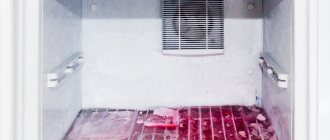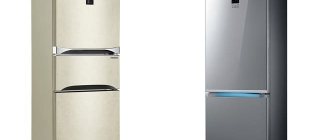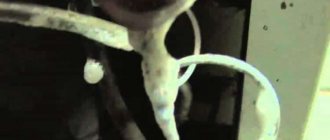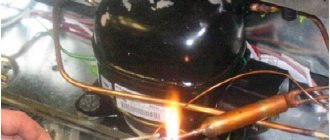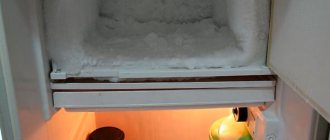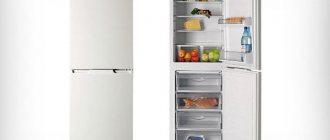Yes, there comes a time when you realize that it’s time—it’s time to defrost the refrigerator. Moreover, this must be done even if you have No Frost. Read how to defrost refrigerators correctly and quickly - old and new, two-chamber and single-chamber, built-in, with a drip defrosting system.
Why and how often to defrost the refrigerator
To extend the life of your household appliances, you need to take care of them regularly. This also applies to the refrigerator, which must be periodically washed and snow build-up removed from it. There are several reasons for the formation of ice, but breakdowns occur due to careless handling of the refrigerator compartment.
In addition to the fact that a thick layer of snow prevents the entire device system from working properly, there is also a risk of leakage and spoilage of products.
If you want to defrost the refrigerator or simply wash it, be sure to disconnect it from the power supply and unplug the cord from the outlet!
Defrosting must be carried out at least once every 12 months. But everything is individual and directly depends on the model. For example, an old Soviet-era refrigerator needs to be cleared of ice every 3 months, but a freezer with the NO-Frost function is enough once every 1 year.
Do I need to defrost my freezer?
If you notice the formation of frost and ice, then defrosting should begin immediately.
Yes, it is necessary, in refrigerators with manual and drip systems. To do this, you will have to turn off the power to the device and create the optimal temperature for melting the ice. In a refrigerator with two compressors, turn off only the freezer compartment.
To speed up the process, open the door and let in warm air from the room.
After defrosting is completed, the refrigerator will need some time to return to its previous cooling temperature. Do not rush to think that a breakdown has occurred, give it time to return to its previous operating mode.
To avoid breakdowns, it is recommended to defrost refrigerators with know frost once a year. But if the formation of frost and ice is noticed earlier, start immediately.
Reasons for the formation of ice in the freezer and on the walls of the refrigerator
- In warm weather, the cooling mode is turned on to maximum.
- The “super freezing” mode works, which is turned on manually (applies to some models).
- Failure of the air temperature sensor in the freezer or refrigerator compartment.
- Failure of the thermostat, which is located in the evaporator. This prevents a signal from being sent to suspend the cooling mode.
- The drain hole in a refrigerator with a drip system is clogged.
- The ice defrosting mode has stopped working.
- A freon leak has occurred and as a result the freezer is running non-stop.
- The door seal is worn out, resulting in warm air entering, disrupting the operation of the entire system.
- The capillary pipeline is clogged, making it difficult to circulate the cold supply.
- The solenoid valve has failed. The mode of switching cooling between compartments does not work (applies to two-chamber refrigerators).
If ice starts to form for no apparent reason, call a technician from the appropriate service center. And when he arrives, disconnect the unit from the power supply, defrost and wash the refrigerator. How to defrost a refrigerator correctly, read on.
Defrosting systems and defrosting frequency
Modern refrigerators are equipped with automatic defrosting systems. They are usually absent in budget options or older models.
Before you start defrosting, you need to look in the technical data sheet to see what kind of defrosting system the refrigerator is equipped with. There are three types in total: “No Frost”, drip, manual.
- The “No Frost” defrosting system has a constantly running fan and evaporator. The fan continuously distributes cool air inside the chamber. However, when warm air from outside gets in, condensation forms inside the chamber. It settles on the evaporator and turns into frost. When the evaporator is heated, the frost melts and flows through special drainage holes into the pan, from where it evaporates. The defrosting system in refrigerators of this type is hidden. For preventive purposes, it is enough to defrost once a year.
- Drip defrosting system
equipped only with an evaporator built into the rear wall of the unit. When the compressor is running, ice may form on the evaporator. At rest, when the compressor is turned off, it melts, the drops flow into a special drain hole and fall into the pan, where they evaporate. There are models that have a warning system about the need for defrosting. Under normal conditions, defrosting refrigerators with a drip defrosting system is sufficient to do 1-2 times a year. - Refrigerators that do not have an automatic defrost system require manual defrosting more frequently. Defrosting can be carried out from once a month to once every six months. This depends on the rate of frost formation in the chamber; a layer of 5-7 mm requires defrosting.
But, regardless of the refrigerator model, it requires regular maintenance and defrosting. Every refrigerator needs to be defrosted at least once a year. If the power in the house is often cut off for a long time, then defrosting is required at least once every 4 months.
Do I need to defrost the refrigerator no frost
refrigerators claim that with the NO FROST system (translated as “no frost”) you can forget about defrosting forever. All thanks to the operating principle: air circulation is distributed evenly throughout the chamber using a built-in fan. Ice simply does not have time to form. In addition, defrosting of the equipment is fully automated. The water flows down the back wall into the drainage hole, where it evaporates from the heat of the compressor.
But the no frost refrigerator still has to be defrosted if you allow this hole to become clogged. Therefore, it is very important to regularly clean the drainage hole from accumulated water and dirt.
In addition, at least once a year, ordinary wet cleaning of the inside of the refrigerator and freezer is needed. And to do this, you will have to disconnect the device from the power supply, remove the food, remove the shelves, and rinse everything thoroughly.
Secondly, when leaving for a long time (on vacation, on a multi-month business trip), it is unwise to leave the refrigerator on.
IMPORTANT! You should not turn off the refrigerator and defrost it if you are leaving for a short time: many modern models (Indesit, Samsung, Liebherr, etc.) have a Holiday or similar function, which allows you to store the remaining food at the minimum permissible temperature and minimizes energy consumption. Read the operating instructions for your refrigerator!
How to defrost a refrigerator correctly (sequence of actions)
The safest way to defrost a refrigerator is to leave it with the door open for several hours. Typically this process can take from 3 to 12 hours. But if the layer of ice is very large, it may take up to 24 hours for complete defrosting. So, what is the sequence of actions when defrosting?
- Open the refrigerator door after turning it off and emptying it of food and removable parts.
- Place containers for draining water under the drain holes if the model does not provide special trays.
- Wait until completely thawed at room temperature. If there is a lack of time, the process can be accelerated. A container of hot water placed on a towel inside the refrigerator will help it melt faster. But the refrigerator door must be closed. Don't forget to change the water to hot water as it cools down. Some housewives advise using a household hot air hair dryer or a heater placed in front of the open refrigerator door. But experts do not recommend using these methods.
- Brush or vacuum the outside of the back of the refrigerator.
- Rinse all removable parts with warm water: shelves, drawers, containers, grids, etc. A solution of baking soda or vinegar will help remove the odor.
- Washing can begin after complete thawing, when water stops leaking and dripping from the drainage holes. Prepare warm water or a cleaning solution (you can add baking soda, vinegar, or a mild detergent to the water). Manufacturers prohibit the use of abrasive or chlorine-containing products, as well as solvents, for cleaning refrigerators.
- After dampening the cloth, wipe the inside of the refrigerator and freezer from top to bottom. Try to thoroughly clean all hard-to-reach areas.
- Carefully clean the ventilation holes in refrigerators with the “No Frost” system with cotton swabs (the ventilation grille must not be unscrewed). For refrigerators with other systems, clean the drain holes. In models with a drip defrosting system, a special brush is included for this purpose.
- Remove dirt from the outside and clean the rubber seal on the door. Try not to stretch it.
- Wash all surfaces of the refrigerator inside and out again with clean water and wipe dry. If water has dripped onto the floor under the refrigerator, it must be removed.
- Place all shelves, containers, etc. in place, leave the refrigerator for 15-20 minutes until completely dry.
- Plug in the refrigerator and wait until the desired temperature is reached. This will take 2-3 hours. After placing the food, try not to open the refrigerator for some time, the temperature should return to normal.
Proper and timely defrosting of the refrigerator will help extend its life and reduce energy costs.
Preparing the refrigerator for defrosting
- Turn the temperature control to zero (it's usually at the top).
- Unplug the cord from the outlet.
- Open the door wide open.
- Place a cloth on the bottom compartment and under the refrigerator.
- Pull out the food and shelves, leaving the chamber completely empty.
Defrosting the refrigerator in stages
You can start cleaning the refrigerator compartment when the temperature has become a little warmer, but to clean the freezer you need to wait until there is no ice left in it. There are options for quick defrosting, but it is better to let the natural process take place.
- Wash the removed shelves and containers and leave them to dry.
- Use a dry cloth to soak the puddles and grab the rest of the debris.
- Wet a napkin with soapy water and carefully walk inside and out. However, you should not use powders or abrasives to avoid scratching the surface.
- Rinse the drain hole if it is a drip defrosting system.
- Clean dirt between the folds of the rubber door seal.
- Then wipe everything dry.
- Let's move on to the freezer - remove the broken ice and snow, pour out the liquid from the pan, and remove the rag.
- After the ice build-up is gone, repeat the cleaning procedure in the freezer.
- Place clean shelves and trays.
- Close the door tightly.
- Plug the cord into the outlet.
- Wait 30 minutes and only then return the food to the refrigerator.
Here is a detailed video instruction on how to defrost a two-chamber refrigerator:
General defrosting rules
Regardless of what system the freezer is equipped with, the general procedure for clearing snow from it will be approximately the same.
Preparing for defrosting
- The freezer must be disconnected from the power supply. If possible, move it a little away from the wall.
- The inner chamber must be completely unloaded. This is the best time to put things in order: remove expired items, compactly pack frozen items, etc.
- Everything that can be dismantled must be removed. These can be doors, drawer fronts, shelves, additional drawers and trays. They must be washed separately in a mild soap solution.
- The pan in which you plan to collect water is placed under the drain holes of the system (usually in front at the bottom).
- The refrigerator door must be opened for several hours. During this time, all the ice melts naturally.
- You need to prepare everything you need for cleaning: detergents, rags, etc.
Place a water tray in front of the refrigerator
Procedure for defrosting
In parallel with defrosting, the refrigerator must be washed. This is the most convenient time to remove dirt that inevitably appears during operation, rid the interior of odors, and restore cleanliness and order.
- The refrigerator should be washed when it is 100% thawed and all the water has gone. While the snow is melting, you can remove large debris.
- From the back outside you need to remove dust, sometimes even cobwebs. This can be done conveniently with a soft brush or vacuum cleaner.
- Any mild, non-abrasive detergent solution will do. If you need to remove an unpleasant odor, you can use a solution of vinegar (1:1 with water) or baking soda (15 g per 0.5 liter of water).
- Use a soft sponge or rag with detergent to wipe all surfaces from top to bottom, including hard-to-reach places.
- Drainage, drainage, and ventilation passages must be freed from deposits that can clog them. In No frost devices, the ventilation ducts are cleaned with a cotton swab. The drain passages can be washed with the pressure of a washing solution, using a bulb or syringe.
- The outside of the refrigerator is also wiped with detergent.
- The sealing elements can be washed with a toothbrush or bottle brush. This must be done carefully so as not to overstretch or deform the elastic bands.
- Once the detergent has been applied to surfaces, it takes 10-15 minutes to work. During this time, you can wash the removable elements and accessories.
- It is necessary to remove the cleaning solution from the surfaces and then wipe them dry.
- Collect everything that was dismantled. Connect the refrigerator to power.
Attention: refrigerators with two independent compressors can be turned off and washed one at a time.
Note to the hostess
- The refrigerator should stand for some time after washing. He needs to ventilate and dry completely.
- Do not forcibly chip away at the ice; this could damage the elements of the device. The ice should thaw on its own.
- Do not expose the refrigerator to temperature shock. It is better to defrost it on a cool day so that there is no sudden temperature difference.
- Abrasive cleaning powders and cleaning accessories should not be used. They will damage at least the decorative coating.
- A device with a No frost system should not be left without power for less than 2 hours, this will harm the motor.
How to speed up defrosting
How to quickly defrost a refrigerator if you are in a hurry and need to activate this process?
- Place a heating pad or plastic bottle with hot water inside the freezer, periodically changing the contents of the container.
- Or place a pot of boiling water in the freezer.
- Spray hot water on the frozen walls every 15 minutes.
- You can direct the hot air of a hairdryer to snowy areas, while observing safety precautions. Make sure that the dryer is at a good distance and the cord does not come into contact with water.
- Using a rag soaked in boiling water, blot the resulting build-up. To avoid getting burned, use rubber gloves.
Tips for storing food during the process
- When defrosting the refrigerator in winter, we put all the food in a bowl, take it out to the balcony or hang bags of food out the window.
- Food from the freezer can also be placed in a large container and wrapped in a thermal insulation layer - a cotton blanket, a warm coat. Freezer food will stay fresh if you place it in a bowl filled with cold water.
- Place food in a thermos or cooler bag while it defrosts in the refrigerator, which will keep it cold for 2-4 hours. An ice pack or dry ice placed in a bag or bag will help extend the shelf life of foods.
Features of defrosting a two-chamber refrigerator
Double compartment refrigerators are those that have a separate door for each compartment. Most often, the refrigerator and freezer compartments operate independently of each other and have a mixed defrosting system. In this case, shutdown and cleanup occur in turn. Which is very convenient for temporary storage of food while one section is defrosting and the other is working.
Otherwise, defrosting occurs in the usual way, only it is important to maintain order - first the refrigerator compartment is cleaned, then the freezer. Don't forget to make sure that water from the upper compartment does not fall on the lower part of the compartment.
Rules for cleaning refrigeration chambers
Contained in SanPin and recommendations of the Institute of Refrigeration Equipment.
The first thing that should be established at a catering establishment is the systematic maintenance of a log of general cleaning of equipment. It contains the following information:
- refrigeration chamber number;
- date of processing;
- name of the sanitary product;
- names of the employees who carried out the cleaning.
Workers must take turns cleaning. Their responsibilities: constantly and carefully monitor the condition of the equipment, monitor the expiration date of the contents. Expired product should be thrown away immediately.
Additional recommendations for creating a cleaning log:
- set exact days for daily cleaning of refrigeration equipment;
- set dates for general cleaning;
- allocate sections for certain types of products indicating exact shelf life;
These rules must be recorded on paper and placed in a visible place.
How to quickly defrost an old single-chamber refrigerator
Older refrigerator models are most often single-chamber and defrost manually. In principle, the defrosting method described above is more suitable for old, single-chamber refrigerators. Double-chamber refrigerators and those with the know-frost system require much less attention.
When defrosting the freezer of an old refrigerator, be careful not to use metal scrapers or other objects to clear ice from the unit.
Watch a short video on how to quickly defrost a regular, old refrigerator in just an hour:
How to turn on the refrigerator after defrosting
You can turn on the refrigerator after it has been disconnected from the network no earlier than 24 hours later. If you need to do this earlier, it is acceptable to start the unit after 12 hours. However, it is not recommended to do this every time.
Please note that by the time you turn on the refrigerator, it must be completely dry after washing. Only when the moisture has evaporated can you turn it on and set the desired mark on the thermostat. You do not need to load the unit with food immediately; it should “get cold” within 1–2 hours.
By following defrosting recommendations, you will keep your expensive unit in working condition for a long time.

